I use two batteries and a galvanometer to observe the "appearance" of electrical energy. Then, I repeat the process with a moving magnet/coil to comprehend their role in generating electricity.
I use a marble that falls from a height, move the magnet, and discuss the energy conversions involved.
Instead of using a marble and a simple magnet movement, I use water and continuous rotation of the magnet in front of the coil—demonstrating a model, based on the operating principle of a hydroelectric power plant.
Summarize the previous steps through an interactive video simulating the operation of a hydroelectric power plant.
